
1.Introduction to Search Engine Optimization
1.1 What is SEO?
Search Engine Optimization (SEO) is the process of optimizing a website to rank higher on search engine results pages (SERPs). This involves improving the quality and quantity of website traffic through organic search engine results. As an essential part of digital marketing, SEO ensures your website is visible to the right audience, driving more potential customers to your business.
1.2 Importance of SEO in Digital Marketing
In the digital age, having a solid online presence is crucial. SEO is a powerful tool that helps businesses increase their visibility, attract more traffic, and boost their sales. A well-optimized website can reach a wider audience, build brand credibility, and generate a higher return on investment (ROI). For businesses in Vikaspuri looking to grow, partnering with a reliable SEO service provider like DigiClock can make a significant difference.
1.3 How SEO Has Evolved Over Time
SEO has evolved significantly since its inception. Initially, it was all about keyword stuffing and link spamming. However, search engines like Google have become more competent, focusing on user experience and content quality. Today, SEO involves a holistic approach that includes technical optimization, quality content creation, and ethical link-building practices.
2.Basics of Search Engine Optimization
2.1 On-Page SEO vs Off-Page SEO
On-page SEO refers to optimizing individual web pages to rank higher and earn more relevant traffic. This includes optimizing title tags, meta descriptions, header tags, and content. Off-page SEO, on the other hand, involves activities outside your website to improve its ranking, such as backlink building and social media engagement.
2.2 White Hat, Black Hat, and Grey Hat SEO
White hat SEO involves ethical practices that comply with search engine guidelines. Black hat SEO uses manipulative techniques that can lead to penalties. Grey hat SEO falls somewhere in between, using methods that aren’t explicitly banned but may still be risky.
2.3 Understanding Search Engine Algorithms
Search engines use complex algorithms to determine the relevance and quality of websites. Understanding these algorithms is crucial for effective SEO. They consider keyword relevance, website structure, user experience, and backlink quality.
3.Keyword Research
3.1 What is Keyword Research?
Keyword research is finding and analyzing search terms that people enter into search engines. It helps identify popular keywords and understand user intent.
3.2 Tools for Keyword Research
Tools like Google Keyword Planner, SEMrush, and Ahrefs are essential for effective keyword research. They provide insights into search volume, competition, and keyword difficulty.
3.3 How to Choose the Right Keywords
Choosing the right keywords involves finding a balance between search volume and competition. Long-tail keywords, which are more specific phrases, often have lower competition and higher conversion rates.
3.4 Long-Tail vs. Short-Tail Keywords
Long-tail keywords are longer and more specific, while short-tail keywords are shorter and more general. Long-tail keywords are often easier to rank for and attract more targeted traffic.
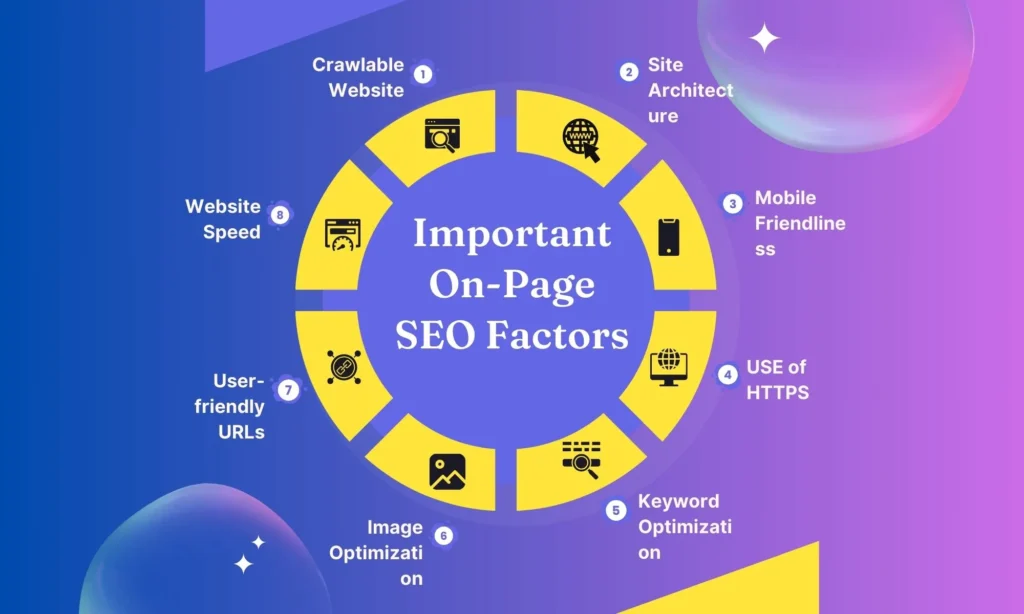
4.On-Page Search Engine Optimization
4.1 Title Tags and Meta Descriptions
Title tags and meta descriptions are crucial for on-page SEO. They summarise your page content and help search engines understand what your page is about.
4.2 URL Structure and Best Practices
A clean and descriptive URL structure improves user experience and search engine indexing. URLs should be short, descriptive, and include target keywords.
4.3 Header Tags (H1, H2, H3, etc.)
Header tags help organize content and make it easier for users and search engines to understand the structure of your page. Use H1 for the main title and H2 and H3 for subheadings.
4.4 Image Optimization (Alt Text, File Names)
Optimizing images using descriptive file names and alt text improves accessibility and helps search engines understand the content of your photos.
4.5 Internal Linking Strategies
Internal linking helps distribute link equity across your site, improves navigation, and helps search engines understand the relationship between pages on your site.
4.6 Creating SEO-Friendly Content
Creating high-quality, relevant, and engaging content is crucial to SEO success. Focus on providing value to your audience and naturally incorporating keywords.
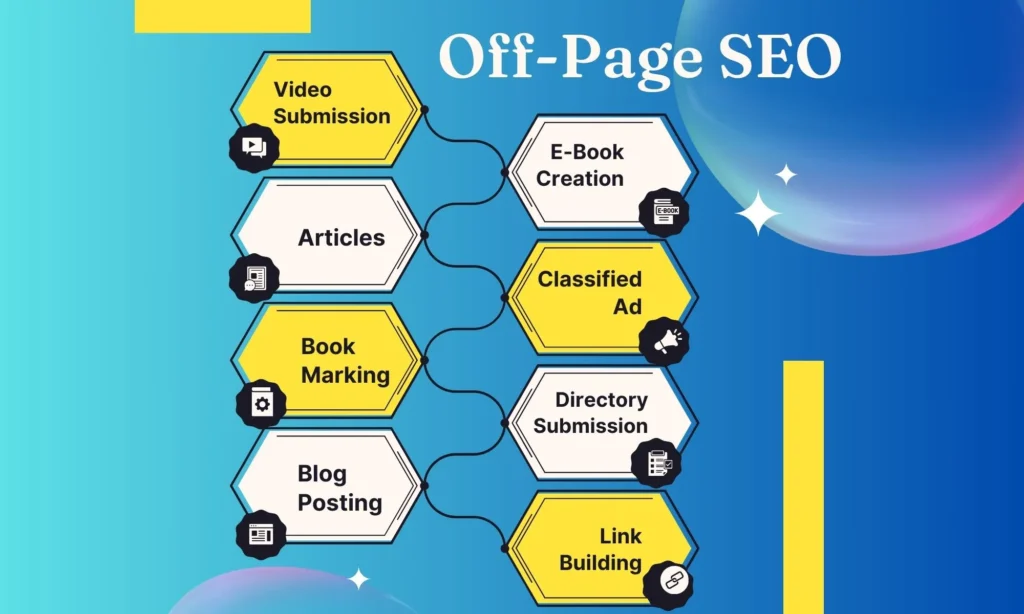
5.Off-Page Search Engine Optimization
5.1 The Importance of Backlinks
Backlinks from reputable sites signal to search engines that your content is valuable and trustworthy. Quality over quantity is crucial for effective backlink building.
5.2 Strategies for Building Quality Backlinks
Effective strategies include guest blogging, influencer outreach, and creating shareable content. Avoid black hat techniques like buying links, which can result in penalties.
5.3 Social Media and Search Engine Optimization
While social media signals aren’t a direct ranking factor, a solid presence can drive traffic and indirectly improve SEO by increasing brand awareness and backlink opportunities.
5.4 Guest Blogging and Outreach
Guest blogging on reputable sites can help build backlinks and establish authority in your niche. Outreach efforts should focus on building genuine relationships and providing value.
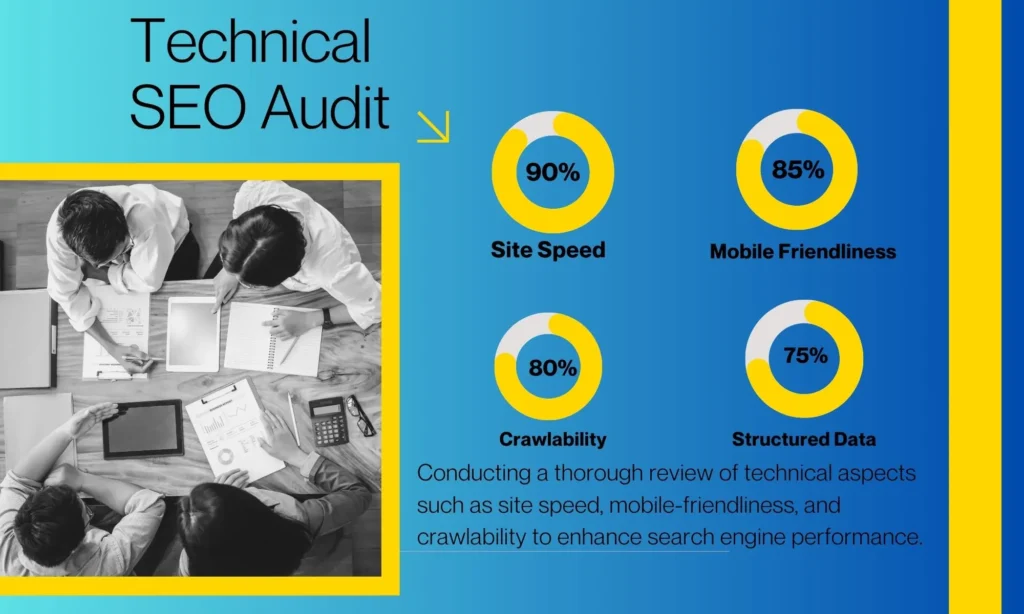
6.Technical Search Engine Optimization
6.1 Site Speed and Performance
A fast-loading site provides a better user experience and is favoured by search engines. Tools like Google PageSpeed Insights can help identify and fix performance issues.
6.2 Mobile-Friendliness
With the rise of mobile usage, having a mobile-friendly site is essential. Responsive design ensures your site looks good and functions well on all devices.
6.3 XML Sitemaps
An XML sitemap helps search engines crawl and index your site more effectively. It provides a roadmap of your site’s structure and content.
6.4 Robots.txt File
The robots.txt file tells search engines which pages to crawl and which to ignore. Proper configuration can prevent search engines from indexing duplicate or irrelevant content.
6.5 Canonical Tags
Canonical tags help prevent duplicate content issues by specifying the preferred version of a webpage. This ensures that search engines attribute the correct page as the source.
6.6 HTTPS and Secure Sites
Switching to HTTPS encrypts data between the user and your site, improving security and trust. Google also considers HTTPS a ranking factor.
7.Local Search Engine Optimization
7.1 What is Local SEO?
Local SEO optimises a website to rank higher for local search queries. It’s essential for businesses targeting customers in specific geographic areas.
7.2 Optimizing for Google My Business
Claiming and optimizing your Google My Business listing is crucial for local SEO. Ensure your business information is accurate and complete.
7.3 Local Citations and Directories
Local citations in directories like Yelp and Yellow Pages can improve local search visibility. Consistent NAP (Name, Address, Phone) information is critical.
7.4 Reviews and Ratings
Positive reviews and ratings build trust and can boost local search rankings. Encourage satisfied customers to leave reviews on Google and other relevant platforms.
8.Content and Search Engine Optimization
8.1 The Role of Content in SEO
Content is king in SEO. High-quality content attracts visitors, encourages engagement, and earns backlinks.
8.2 Creating High-Quality Content
Focus on creating informative, engaging, and original content that provides value to your audience. Mix text, images, and videos to keep it interesting.
8.3 Content Marketing Strategies
Content marketing involves creating and distributing valuable content to attract and retain an audience. Blogging, infographics, and video content are effective strategies.
8.4 Content Update and Refresh
Regularly updating and refreshing your content ensures it remains relevant and valuable. This can also improve your search engine rankings.
9.Search Engine Optimization Analytics and Tools
9.1 Google Analytics for SEO
Google Analytics provides insights into website traffic, user behaviour, and conversion rates. Use it to track your SEO performance and make data-driven decisions.
9.2 Google Search Console
Google Search Console helps monitor and maintain your site’s presence in Google search results. It provides valuable data on search queries, indexing issues, and more.
9.3 Other Useful SEO Tools
Tools like SEMrush, Ahrefs, and Moz offer comprehensive SEO analysis, keyword research, and backlink tracking features.
9.4 Measuring and Interpreting SEO Metrics
Understanding metrics like organic traffic, bounce rate, and conversion rate is crucial for evaluating your SEO efforts and making necessary adjustments.
10.Standard SEO Mistakes to Avoid
10.1 Keyword Stuffing
Overusing keywords can lead to penalties and negatively impact user experience. Focus on natural keyword integration.
10.2 Duplicate Content
Duplicate content needs to be clarified for search engines, which can lead to lower rankings. Ensure all content on your site is unique and original.
10.3 Ignoring Mobile Optimization
With more users accessing the internet via mobile devices, ignoring mobile optimization can hurt your rankings. Ensure your site is mobile-friendly.
10.4 Poor Quality Backlinks
Low-quality backlinks from spammy sites can harm your SEO efforts. Focus on earning high-quality, relevant backlinks.
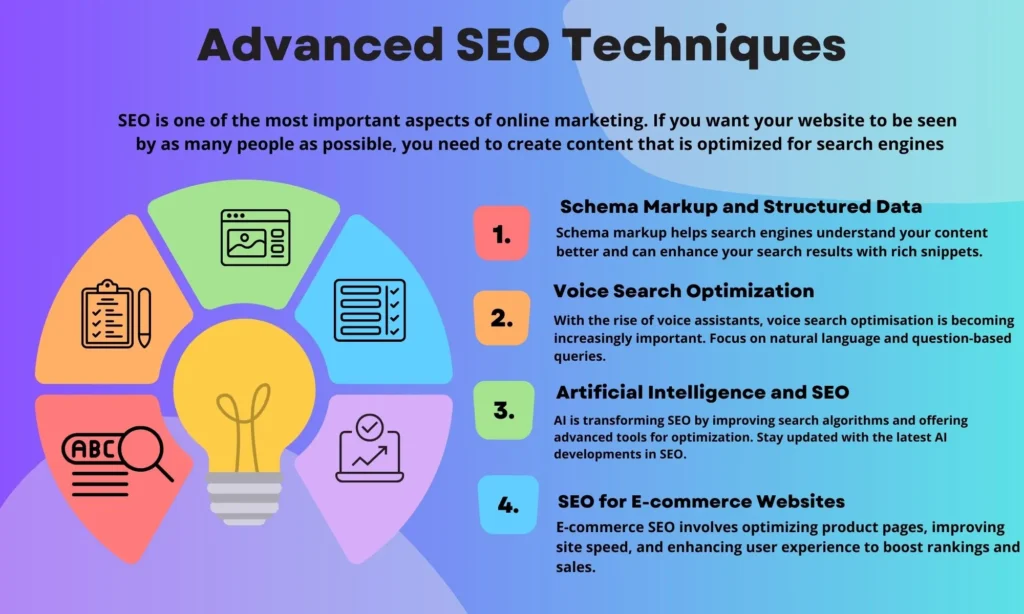
11.Advanced SEO Techniques
11.1 Schema Markup and Structured Data
Schema markup helps search engines understand your content better and can enhance your search results with rich snippets.
11.2 Voice Search Optimization
With the rise of voice assistants, voice search optimisation is becoming increasingly important. Focus on natural language and question-based queries.
11.3 Artificial Intelligence and SEO
AI is transforming SEO by improving search algorithms and offering advanced tools for optimization. Stay updated with the latest AI developments in SEO.
11.4 SEO for E-commerce Websites
E-commerce SEO involves optimizing product pages, improving site speed, and enhancing user experience to boost rankings and sales.
12. The Future of Search Engine Optimization
12.1 Emerging Trends in SEO
Keep up with emerging trends like mobile-first indexing, AI, and machine learning.
12.2 The Impact of AI and Machine Learning
AI and machine learning are reshaping SEO by enhancing search engine algorithms and offering advanced analytics tools.
12.3 Preparing for Future SEO Challenges
SEO is constantly evolving. Stay adaptable and continuously update your strategies to keep up with changes in search engine algorithms.
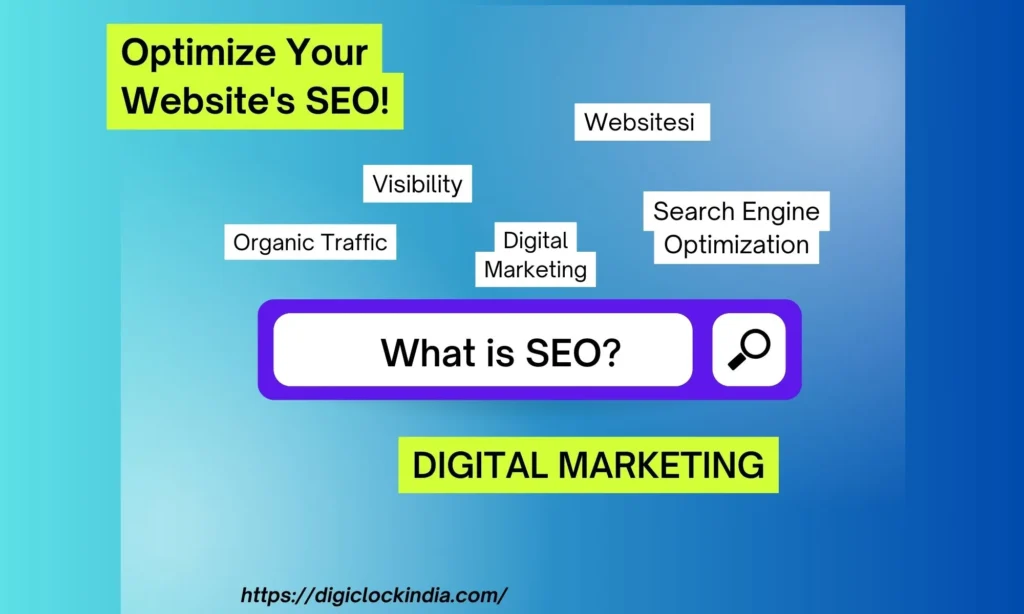
13.Frequently Asked Questions (FAQs)
13.1 What is SEO, and why is it important?
SEO stands for Search Engine Optimization. It is essential because it improves your website’s visibility, attracting more traffic and potential customers.
13.2 How long does it take to see results from SEO?
SEO is a long-term strategy. Depending on your industry’s competitiveness and the effectiveness of your strategies, results can typically be seen within 3 to 6 months.
13.3 What are the best tools for SEO?
Some of the best SEO tools include Google Analytics, Google Search Console, SEMrush, Ahrefs, and Moz.
13.4 Can I do SEO alone, or do I need a professional?
While basic SEO can be done independently, partnering with a professional SEO expert or agency like DigiClock can ensure more effective and sustainable results.
13.5 What is the difference between on-page and off-page SEO?
On-page SEO involves optimizing individual web pages, while off-page SEO focuses on activities outside your website to improve its ranking.
13.6 How do backlinks affect my SEO?
Backlinks from reputable sites signal to search engines that your content is valuable and trustworthy, improving your site’s ranking.
13.7 What is the role of content in SEO?
High-quality content attracts visitors, encourages engagement, and earns backlinks, which are crucial for SEO success.
13.8 How often should I update my SEO strategy?
SEO is an ongoing process. Your strategy should be regularly updated based on performance data, industry trends, and changes in search engine algorithms.
14. Conclusion
14.1 Recap of Key Points
SEO is a critical component of digital marketing that involves optimizing your website to improve its visibility on search engines. It encompasses various techniques, including keyword research, on-page and off-page optimization, and technical SEO.
14.2 The Continuous Nature of SEO
SEO is not a one-time task but a continuous effort. To stay effective and relevant, it requires regular updates, monitoring, and adjustments.
14.3 Encouragement to Start Implementing SEO Strategies Today
Start implementing effective SEO strategies today to boost your online presence and drive more traffic to your website. For businesses in Vikaspuri, partnering with a reputable SEO company like DigiClock can provide the expertise and support needed to achieve your digital marketing goals. Whether you need an SEO service provider, an SEO agency, or an SEO trainer, DigiClock offers comprehensive solutions to help you succeed.
